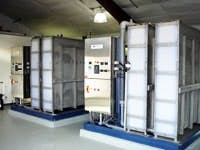Located in Northwest Colorado, the Town of Oak Creek is a modest-sized community with a diverse landscape of mountainous peaks and rolling ranch land. It's these mountainous peaks and the subsequent seasonal run-off that was one of the drivers in this fast track design-build project.
Anticipating the Spring run-off season and the need to treat a wide range of raw water quality, the Town of Oak Creek developed a fast track, design-build schedule to find a solution to its water treatment needs.
The town's water treatment system was an antiquated 1940’s conventional water treatment plant, which had been updated sporadically over time, but was worn out. The town needed a new system that would be cost effective and easy to operate and maintain by one person.
After careful evaluation, the design-build team of Carter & Burgess and Schmueser & Associates recommended a water treatment system that included a submerged membrane package system, which offered a small footprint, low headroom and the flexibility to meet future drinking water regulations.
The membrane filtration system consists of two USFilter MEMCOR® AXIA units. The system is a skid mounted, self-reliable unit. All required controls, instrumentation, blowers, compressors and pumps needed for a fully functional system are included. Each skid is 15 feet long, 7.5 feet wide. The height of each unit is 9 feet.
For easier access, modules are removed from the front of the unit. Because of this removal method, the system requires less height than the other systems of its capacity--meeting the building height requirements. With each module only weighing 12.5 lbs, the system also allows reduced operator maintenance as only one plant operator is required to maintain the system.
Using one unit, the Town will produce 200 to 400 gpm. With two units on-line, the town has the flexibility to achieve up to 800 gpm.
A three-month pilot study, during the coldest part of the year, confirmed the unit's flow rates, but also the backwash, clean in place (CIP) and recovery of the overall system. Based on the pilot, the system will be able to achieve longer CIP intervals and higher recoveries than initially anticipated--even when treating water with a temperature less than 1 degree C.
The system went fully operational on October 7, 2004, and is meeting every expectation according to Jim Photos, the city plant manager. He said they have had no problems with the system and (jokingly) “my only concern is that the plant is running so well we think something could be wrong.” Photos also noted that he has received many requests for visits and is proud to serve as the model plant for the installation of these units.


